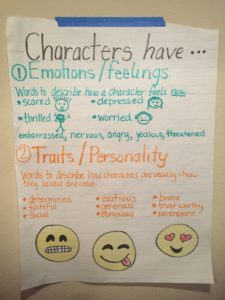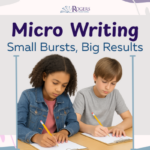
** Contact us if you would like Rogers Education Consulting to come to your campus with engaging, evidence-based, and practical professional development **
I’ll admit it, I have a dark side. Those who know me say it’s deeply hidden behind nervous giggles and an approachable demeanor, but I’m drawn to dark literature. “A Poison Tree,” by William Blake, speaks to me. The dark tone and story of sweet revenge make me smirk. Even if you don’t have a dark side, this poem should be introduced to your students. After all, it’s a classic!
This is week two of my series on poetry in honor of National Poetry Month. If you missed week one, check out last week’s post on by “Harlem,” Langston Hughes.
Before: Activate students’ schema and prepare them to understand the poem by asking them about times they’ve been angry. What makes them angry? Can they remember a time they were so angry they thought they’d explode? Come armed with possible examples: the baseball umpire called foul when it was a strike, your mom asks you to clean your room when your favorite television show is on, someone spreads rumors about you, etc. Once the students have all thought about things that make them angry, ask the students how they handle this anger. Have a lengthy discussion with the students as to how they handle their anger and which ways are best. Introduce the word revenge. Ask students if revenge is a good thing or a bad thing? Ask if getting revenge makes you feel better in the end. Before reading the poem, you might also want to frontload some of the more uncommon vocabulary words used in the poem, such as wrath, foe, deceitful, wiles, and stole.
Middle: Spend the week on this poem! Start by reading this poem aloud to the students. Each student should have a piece of paper and a pencil. As you read the poem aloud, allow each student to draw what they are visualizing. Then read it out loud again. With each repeated read, they can add to the sketch. In addition to sketching, students should write the words that stand out, that made them visualize what they did. Give students time to share their drawings and ask students to write what they feel the poem is saying.
Each day choose a different lens through which to read:
Rhyme Scheme – Have students realize that this poem follows an AABB rhyme scheme in four quatrains. I would read the poem and just ask the students if this is a poem that rhymes. Once the students confirm that indeed the poem rhymes, ask them which words rhyme. Slowly guide them to realizing the rhyming pattern. To take this a step forward, lead the students to notice that the rhyming words have more in common. Each last word is only one syllable. Ask the students why the poet, William Blake, chose to make each last word one syllable. While there is no one right answer, I would lead students to realize how that adds to the harshness of the feelings, it’s almost abrupt. Most students will say that it is strong sounding. I like that too!
Narrative Poem – This is a narrative poem. Meaning it has characters, a setting, and a beginning, middle, and end. Since it is a narrative, spend some time asking students to pull out the elements of the story. What happened in the beginning, in the middle, and in the end. Definitely have the students spend some time on the narrator or main character. How is he feeling? How have his feelings changed as the text develops? Then give time for the students to connect back to themselves. How are their feelings the same or different from the narrator when they are angry with someone?
Tone and Mood – I personally try to not get too caught up in these terms with the students, but I don’t think you can teach this poem without discussing tone and mood. The tone is the author’s particular attitude in the writing and mood is the atmosphere or feeling created in the text. The tone is calculating, ominous, cunning, dark, and aggressive. These words can all be changed depending on the age of students you are teaching. It’s less about them getting the exact word you’re looking for and more about the students coming up with words that really explain the tone in ways they understand. In order to direct students’ thinking about the author’s tone, ask the students how the narrator feels toward his enemy? Always ask the students to support their reasons with text evidence.
Metaphor – The entire poem is an extended metaphor. The entire poem is using the idea of a plant or vegetation as a symbol of his anger and resentment. Blake is comparing his anger growing to a tree growing. Don’t give this to the students, make them “work for it.” Even the youngest student can get there! There are so many small pieces to discuss that, when put together, students will see the big picture. I like to cut the four stanzas apart and give each one to different groups. Have that group discuss the metaphor and meaning of the stanza. Then have them either draw the scene or act out the scene. Bring all the groups together to share their discoveries, and they will begin to see the big picture.
After – Come back to the idea of handling anger. Ask students what the best way to handle anger is and how that compares to what Blake expressed in the poem. Are there nonviolent ways to handle anger? How can you let it go? Is it important to express feelings? There are so many great discussions that can occur here and be continued throughout the school year. As always, I have the students follow up in their journal explaining the meaning of the poem, how it made them feel, and how this connects to them.
I would also pull the message from this poem and make connections to any book the student is reading at the moment. Because I set up my class in a Readers’ Workshop, I am reading a text out loud to the students and each student is reading their own text, which provides at least TWO opportunities for making connections! I would model for students how to analyze the character from the book I am reading out loud. Specifically, I do a think-aloud to analyze how the character is handling anger. Is he letting it fester? Is he letting it go? Is he trying to get revenge? I would make connections between my character and the narrator from the poem. Then have the students do the same thing with a character from the book they are reading.



Love this, thanks!
You’re welcome! I’m glad you are enjoying the poetry posts!